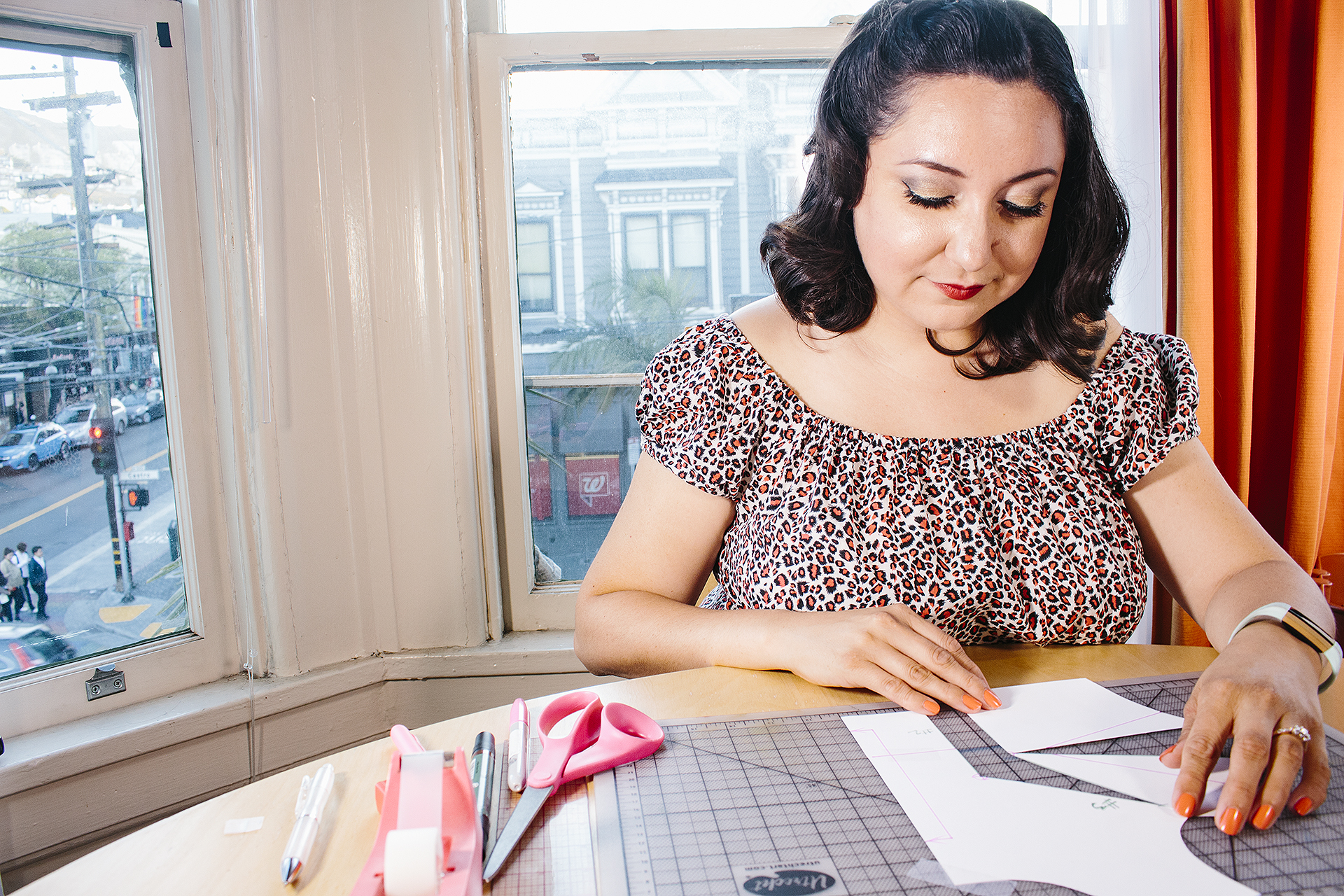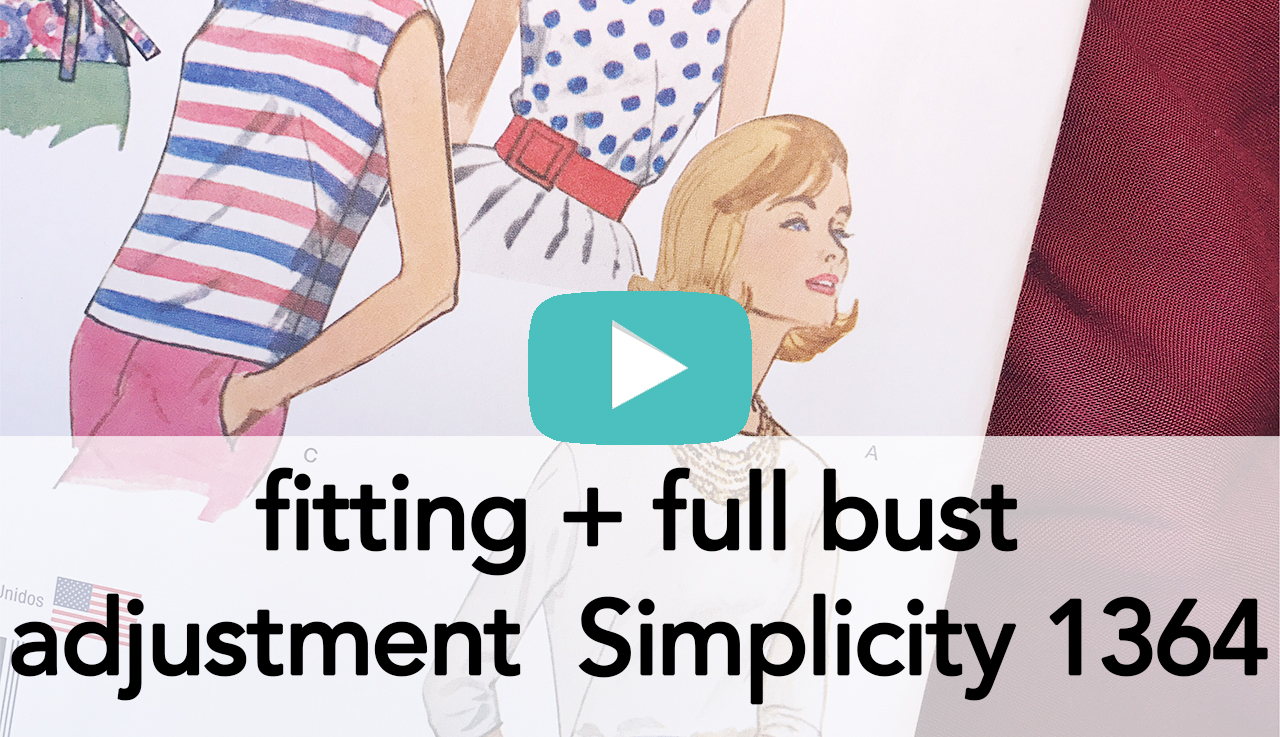If you’re a C-cup or above, doing a full bust adjustment goes hand-in-hand with sewing. This even applies to sewing t-shirts.

I’m sure we’ve all been there: weird drag lines from the arms and above the chest, fabric pulled to its limit, and uncomfortable compression across the front of our bodies which feels and looks terrible, because the fabric and pattern doesn’t have enough give.
Just because it’s sewn with stretchy fabric, doesn’t mean that t-shirt is going to fit correctly.
In enters the No-Dart Full Bust Adjustment, perfect for those shirts and knit dresses that just need a little bit of extra space across the bust, creating comfort, removing the “wings” from the garment and adding ease to your piece.
Key components to creating a knit garment for larger chested people are straight forward, but should be done step-by-step.
Testing Your Fabric
Not all knits are the same! Planning on sewing a t-shirt? Test the fabric’s stretch, calculating if it matches the required stretch percentage of the pattern you’re making.
Use the simple formula below to calculate your fabric’s stretch:

Also watch for:
- What does the fabric’s bounce-back look like after it’s been stretched?
- If it bounces back to it’s original size and shape, fantastic!
- If it doesn’t, maybe reconsider the fabric choice, as over time, it’ll warp over the body and wear out poorly.
- Does it look transparent, shiny, or “off” when stretched?
- The fiber content may not be able to support a high stretch or not look as intended when worn.
- Does the fabric warp when stretched?
- Again, will probably not look as intended when worn.
In all cases above, they might work for you and your fabric- but take note regardless. You may find that the look of the stretched version is not what you want to wear across your chest.
Choosing the Right Size for You + Your Fabric
After confirming your fabric is great for your sewing project, it’s time to pick the right size to work from.
Watch the video below if you need help reading a size chart on a pattern:
A few high level things to take into account when selecting a pattern size:
- Choosing your Bust size should be based on your High Bust measurement, with anticipation that a no-dart full bust adjustment will increase both the waist and bust measurements in width.
- Sizing up will also mean sizing up the width of the shoulders and arm scythes– try and match those measurements more closely than the Waist and Bust size. The Waist and Bust measurements can be changed- the others will be substantially more challenging.
Once you select your size, confirm your fabric’s full stretch against the size. Use the formula below to confirm your fabric will indeed stretch to capture your body’s measurements:

Once you’re able to confirm that the fabric will stretch to your measurements based on the selected size, you’re ready to move on to doing sewing pattern adjustments.
Doing the No-Dart Full Bust Adjustment
No Dart Adjustment =/= there are no darts involved! Instead, it means we have to use dart methodologies to get the adjustment done.
First, decide how much of an FBA you have to do, using the general guidelines below:

If your fabric is low stretch, you may need to make a half muslin and measure out the distance between the center front of your muslin and the center front of your body, as demonstrated in the image below:

Once this number is found, you’re able to move onto the sewing adjustment.
Step One: Complete a “regular” Full Bust Adjustment [Timestamp: 09:36]
If the pattern has a bust point indicated, follow the normal steps to completing a full bust adjustment. If the pattern does not have a bust point indicated, watch my video for how to identify this location on your pattern, based on your measurements.
Step Two: Rotate the Dart to the Bottom of the Pattern [Timestamp: 18:43]
Cut out the side dart, and rotate the side dart closed, pivoting the dart to the bottom of the pattern. Tape the side dart closed and fill in paper at the bottom of the pattern piece.

Step Three: Rotate the Dart… OUT! [Timestamp: 21:23]
To complete the no-dart full bust adjustment, rotate the dart out from the side of the pattern. Measure the size of the dart from Step Two, and take the distance out from the side seam. From there, true out the side seam, to make a smooth curve matching the original pattern shape as closely as is reasonable. Then, walk your pattern seam.
Unsure of how to walk your pattern pieces? Watch the video below to learn how:
Step Four: Complete the Full Bust Adjustment
After walking your side seam, make sure the pattern hasn’t been lengthened too long in the front. Measure the center front and compare that to you– if it’s too long, bring it up. But make sure to keep a touch of extra length, to allow the fabric to comfortably go over your chest.
Step Five: Sew your Final Muslin
Especially if this is your first time doing a no-dart full bust adjustment, I highly recommend doing this step. If you’re a seasoned seamstress, this may not be needed.

Like what you see?
![How To: No-Dart Full Bust Adjustment [2022 Update]](https://vintageontap.com/wp-content/uploads/2022/04/nodartfba_needsadjustment2.jpg)



























